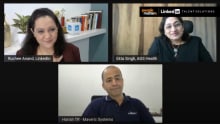OneHR: Diversity is everybody’s business
One HR Read similar articles

For human resource leaders, the lessons from the tumultuous year of 2020 (so far) are that HR has an unequivocal mandate to create equity initiatives that drive positive change for ALL stakeholders in their organizations. While organizations around the world understand the need for diversity and are putting efforts to create a more diverse and inclusive work (workplaces), the progress doesn’t seem to be much. Programs designed to increase diversity and inclusion in the workplace often fail.
The key is to move just beyond D&I initiatives and embrace equity, belonging, KPI-led agenda, and the right hiring tools.
In a recent panel discussion by People Matters and LinkedIn Talent Solutions, leaders from India and South East Asia came together to reflect upon the emerging Diversity, Inclusion, and Belonging (DIBs) needs, and share some of the best practices and policies from their organizations to make a positive shift in the DIBs needle. Themed around, OneHR: Diversity is everybody’s business, the panel discussion was moderated by Ruchee Anand, Senior Director - Talent and Learning Solutions along with Sunita Rebecca Cherian, Chief Culture Officer & Senior Vice President - Human Resources at Wipro, Madhu Srivastava, Group CHRO, Vedanta, and Paul Choi, Group Head of Human Resources at Hong Kong Exchanges and Clearing Limited.
Here are some key takeaways from the session:
Organization’s journey in making progress in the D&I agenda
Traditionally, an organization’s D&I priorities lie in making gender diversity work and the focus has always been around increasing the number of women in the workforce.
Sharing the evolution of D&I journey in Hong Kong Exchanges & Clearing Limited, Paul Choi, Group Head of Human Resources, shared, “As a company, we have achieved pretty good diversity, especially in terms of gender, age groups, ethnicity, etc. However, there is still work to do. For us, and also for other profit organisations, the priority lies in making the diverse population work well together. This is also one of our core corporate values, and is higher on our business agenda.”
Reflecting upon how D&I processes have evolved, Sunita Rebecca Cherian, Chief Culture Officer & Senior Vice President - Human Resources at Wipro shared that, with the evolving nature of work and ecosystem, it's important to unlearn, learn, relearn. Continuing to stick to the old ways of working is not going to drive any value. It's important for us to listen to what employees say, what they think, and how you can co-create a truly inclusive environment, and not just by looking at the diversity statistics but at the real-time data and employees’ sentiments.
Embracing D&I across talent lifecycle: Best practices
Reflecting upon making D&I a holistic practice that drives outcome, Paul shared the importance of building the right experience at every step throughout the life cycle. So for Hong Kong Exchanges & Clearing Limited, the D&I journey starts from attracting diverse talent, developing them, creating equitable rewards promotions, and helping them with a growth plan according to the different needs of individual talent.
Aligned with the thought, Madhu Srivastava, Group CHRO, Vedanta also shared some of the practices to imbibe inclusion across the talent lifecycle. Vedanta’s core priority has been around empowering women across roles and levels and they have a strong vision around moving them to the top of the ladder.
Madhu Srivastava, Group CHRO, Vedanta shared that Vedanta has constituted 15 diversity councils which are 100 women strong and look after the empowerment of women talent and look after the various policies constituted for women upliftment, growth, and empowerment. Further, to empower women in leadership positions, Vedanta is running a women leadership program where in the first phase the organization has identified 150 high-potential mid-level women leaders who have the potential to become CXOs. The target is that in the next six to 12 months, the company has to elevate every woman employee into a decision-making role.
Diversity, Inclusion, and Belongingness is a shared responsibility
There’s obviously a wider organisational responsibility to promote and achieve diversity and inclusion but who should be responsible for making it an everyday reality? Should it come from HR, C-suite or the employees themselves? And how can each employee play a role in ensuring their organisation is fostering a diverse and inclusive workforce?
During the panel discussion, a broad consensus was found- driving an inherent adherence to D&I principles is the responsibility of everyone in an organisation. Ultimately, Diversity and inclusion have to be led from the top and lived by all throughout the organisation.
Click here to watch the full session.







